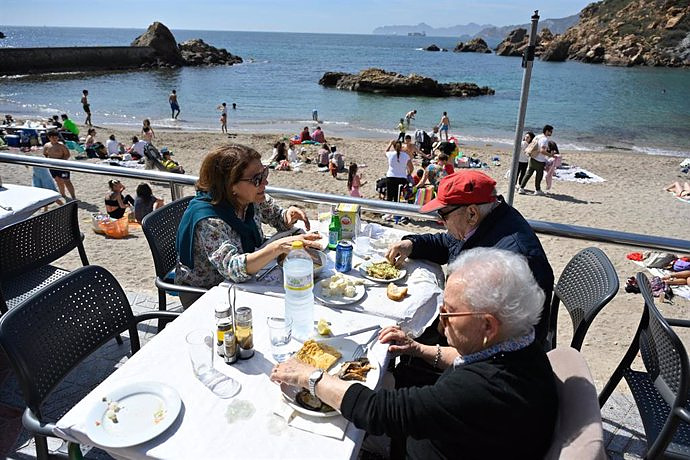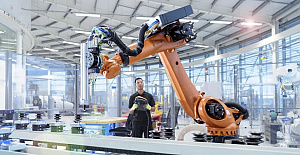In the context of e-commerce, physical stores make their revolution, change in living place, in point of withdrawal, or still in the warehouse. And resume their place in the purchase path and the supply chain.
The e-commerce will he kill the physical store? A few years ago, the idea might seem credible. The thrust of Amazon, the delivery time is always shorter... Everything seemed to condemn it to obsolescence of the retail physical. But this vision itself has become obsolete. At the time of the Internet, the store does not die: it reinvents itself. Not only by becoming more connected: products tagged by radio frequency identification (RFID), touch screens, salespeople equipped with tablets, customization of objects in the store... But also re-evaluating its role in a supply chain adapted to the omni-channel, where online and offline merge. The strength of the pure player Amazon was to not have shops? This is also its disadvantage.
the success of The "click-and-collect"
First idea: make the store an extension of the web, where you come from, to test, to try, to remove it, products labeled or purchased online. This principle of web-to-store is acclaimed by the clients. According to a study Mappy/BVA 2016, 89% of consumers, internet users say they are interested in being able to educate themselves online before making a purchase in a physical trade. And after an investigation, Fevad/CSA 2016, 36% of e-buyers have already used the click-and-collect, the withdrawal shop for a product purchased on the web. These have also been 29% to make other purchases during their visit on-site: evidence that the click-and-collect is not just a mode of delivery, but also a way to attract the customer in the store.
stores without products?
After the web-to-store, has just the opposite trend: the store-to-web. In terms of logistics, a store has its limits: the more one wants to propose different products, the longer it takes the store, and it takes more space. So, why not reduce the stock and install terminal command-line, then deliver customers to home from a warehouse located out of the city? It offers as well as shop an extensive selection, on a surface optimized.
Your support is essential. Subscribe for $ 1 support UsIn France, retailers such as Decathlon, Celio's, or Sephora conduct experiments in this direction. At the bottom, the store-does it still need to contain products? "In the United States, we see the shops which are places of life, where one can read a book, drink coffee, attend classes or events, tells the story of Edouard Moulle, chairman of Viapost Logistics Connected. It is a way to give back value to the physical world compared to the pure-players."
Read our complete file
E-commerce cross-border, adapt to the difference
The future giants of the e-commerce world How to make his hole on a marketplace ? The future of e-commerce has written to the internationalThe shop takes the advantage
Finally, in a very different model, some channels choose to make their stores kinds of warehouses to urban, where the products purchased online are delivered to very short deadlines in the surrounding area. This concept of ship-from-store, for example, has been applied across the Atlantic by giants such as Best Buy or macy's - the first claims a 29% increase of its sales in e-commerce through this. The store takes the advantage on the pure player by his trump card first: its occupation of the territory. And the e-commerce does not destroy most of the store close: on the contrary, the two complement each other.

 Exploring Cardano: Inner Workings and Advantages of this Cryptocurrency
Exploring Cardano: Inner Workings and Advantages of this Cryptocurrency Seville.- Economy.- Innova.- STSA inaugurates its new painting and sealing hangar in San Pablo, for 18 million
Seville.- Economy.- Innova.- STSA inaugurates its new painting and sealing hangar in San Pablo, for 18 million Innova.- More than 300 volunteers join the Andalucía Compromiso Digital network in one month to facilitate access to ICT
Innova.- More than 300 volunteers join the Andalucía Compromiso Digital network in one month to facilitate access to ICT Innova.-AMP.- Ayesa acquires 51% of Sadiel, which will create new technological engineering products and expand markets
Innova.-AMP.- Ayesa acquires 51% of Sadiel, which will create new technological engineering products and expand markets The Prosecutor's Office requests that the AN investigate the detainee for terrorism for damaging an ax in a McDonalds in Badalona
The Prosecutor's Office requests that the AN investigate the detainee for terrorism for damaging an ax in a McDonalds in Badalona Balearic PSOE denounces the director of IbSalut for prevarication for renouncing the mask claim file
Balearic PSOE denounces the director of IbSalut for prevarication for renouncing the mask claim file Otxandiano reproaches that PSOE "has lent itself" to taking out ETA in the campaign, like the extreme right against Sánchez
Otxandiano reproaches that PSOE "has lent itself" to taking out ETA in the campaign, like the extreme right against Sánchez Puigdemont claims to have a "well grasp" of the State and asks to "be respected" to obtain more transfers
Puigdemont claims to have a "well grasp" of the State and asks to "be respected" to obtain more transfers How Blockchain in being used to shape the future
How Blockchain in being used to shape the future Not just BTC and ETH: Here Are Some More Interesting Coins Worth Focusing on
Not just BTC and ETH: Here Are Some More Interesting Coins Worth Focusing on Valencia displays its "innovative and technological potential" at the Emerge Americas event in Miami
Valencia displays its "innovative and technological potential" at the Emerge Americas event in Miami The CSIC incorporates the challenges of robotics, nanotechnology and AI in the new strategic plan for biomedicine
The CSIC incorporates the challenges of robotics, nanotechnology and AI in the new strategic plan for biomedicine Innovation allocates 9.1 million to train 74,000 people and guarantee digital inclusion
Innovation allocates 9.1 million to train 74,000 people and guarantee digital inclusion LIFE SPOT manages to develop new green treatments that eliminate groundwater contamination
LIFE SPOT manages to develop new green treatments that eliminate groundwater contamination A million people demonstrate in France against Macron's pension reform
A million people demonstrate in France against Macron's pension reform Russia launches several missiles against "critical infrastructure" in the city of Zaporizhia
Russia launches several missiles against "critical infrastructure" in the city of Zaporizhia A "procession" remembers the dead of the Calabria shipwreck as bodies continue to wash up on the shore
A "procession" remembers the dead of the Calabria shipwreck as bodies continue to wash up on the shore Prison sentences handed down for three prominent Hong Kong pro-democracy activists
Prison sentences handed down for three prominent Hong Kong pro-democracy activists ETH continues to leave trading platforms, Ethereum balance on exchanges lowest in 3 years
ETH continues to leave trading platforms, Ethereum balance on exchanges lowest in 3 years Investors invest $450 million in Consensys, Ethereum incubator now valued at $7 billion
Investors invest $450 million in Consensys, Ethereum incubator now valued at $7 billion Alchemy Integrates Ethereum L2 Product Starknet to Enhance Web3 Scalability at a Price 100x Lower Than L1 Fees
Alchemy Integrates Ethereum L2 Product Starknet to Enhance Web3 Scalability at a Price 100x Lower Than L1 Fees Mining Report: Bitcoin's Electricity Consumption Declines by 25% in Q1 2022
Mining Report: Bitcoin's Electricity Consumption Declines by 25% in Q1 2022 Oil-to-Bitcoin Mining Firm Crusoe Energy Systems Raised $505 Million
Oil-to-Bitcoin Mining Firm Crusoe Energy Systems Raised $505 Million Microbt reveals the latest Bitcoin mining rigs -- Machines produce up to 126 TH/s with custom 5nm chip design
Microbt reveals the latest Bitcoin mining rigs -- Machines produce up to 126 TH/s with custom 5nm chip design Bitcoin's Mining Difficulty Hits a Lifetime High, With More Than 90% of BTC Supply Issued
Bitcoin's Mining Difficulty Hits a Lifetime High, With More Than 90% of BTC Supply Issued The Biggest Movers are Near, EOS, and RUNE during Friday's Selloff
The Biggest Movers are Near, EOS, and RUNE during Friday's Selloff Global Markets Spooked by a Hawkish Fed and Covid, Stocks and Crypto Gain After Musk Buys Twitter
Global Markets Spooked by a Hawkish Fed and Covid, Stocks and Crypto Gain After Musk Buys Twitter Bitso to offset carbon emissions from the Trading Platform's ERC20, ETH, and BTC Transactions
Bitso to offset carbon emissions from the Trading Platform's ERC20, ETH, and BTC Transactions Draftkings Announces 2022 College Hoops NFT Selection for March Madness
Draftkings Announces 2022 College Hoops NFT Selection for March Madness


























